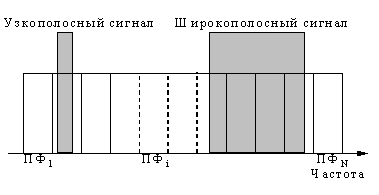Problems of detection and identification of radio signals of covert information control means. Part 2..
Problems of detection and identification of radio signals of covert information control means
Kargashin Viktor Leonidovich
Candidate of Technical Sciences
Special Equipment, No. 4, 2000
Part 2. Efficiency of multichannel receivers
As noted in the first article, signals from special radio engineering means (SREM) of covert information control systems should be considered as random processes in conditions of unknown parameters. The random nature of the signal base determines the structure of the optimal receiver of such signals as an energy one, known as a radiometer. In fact, the optimal receiver for a signal with unknown parameters should be a process power meter that allows identifying energy increments over noise power in the presence of a signal in the analyzed frequency range. Given the unknown frequency of SREM operation, such process power meters should be built in the entire frequency range possible for transmitting covert control signals, as shown in Fig. 1.
Fig. 1
The input signal  , consisting of an additive mixture of signal and interference, is fed to a system of bandpass filters, after which the average power of the filtered process is calculated during the averaging time
, consisting of an additive mixture of signal and interference, is fed to a system of bandpass filters, after which the average power of the filtered process is calculated during the averaging time  . Each frequency channel has its own detection threshold
. Each frequency channel has its own detection threshold  and a decision is made when the power values in the channels are exceeded
and a decision is made when the power values in the channels are exceeded  about the presence or absence of a signal in the original process. Such a receiver is invariant with respect to the frequency range of the signal and the moment of its appearance, since the process analysis in the frequency domain is carried out continuously. It is obvious that with any random signal base, its spectral components will fall into certain frequency bands of the receiver analysis, that is, they will be recorded regardless of the method of distribution of the information signal in the frequency-time continuum.
about the presence or absence of a signal in the original process. Such a receiver is invariant with respect to the frequency range of the signal and the moment of its appearance, since the process analysis in the frequency domain is carried out continuously. It is obvious that with any random signal base, its spectral components will fall into certain frequency bands of the receiver analysis, that is, they will be recorded regardless of the method of distribution of the information signal in the frequency-time continuum.
Possible quasi-optimal variants of realization of receiving systems for detection of SRTS signals are connected with certain specification of the received signal model. However, these models should not go beyond the potential capabilities of energy receivers, i.e. should not specify the type or method of modulation, transformation and coding of the signal. The most significant factor is the transmission time and the spectrum width of the transmitted signal.
The average duration of a signal, for example, per day, is determined by two factors — the duration of the controlled SRTS signal and the degree of information compression. The maximum width of the signal spectrum is also determined by the possibilities of information compression for the purpose of its short-term transmission or increasing noise immunity by expanding the frequency band. The minimum width of the signal spectrum with a duration greater than the original duration of the signal is advisable when trying to implement signal secrecy, for example, by energy coverage with another signal. At the same time, such a signal will have an increased duration, which increases the likelihood of its detection.
It should be noted that the SRTS is most likely not a logical intelligent device capable of performing the functions of semantic thinning of the information flow, the tacit control of which is carried out, that is, to intercept only information of interest. In this case, the SRTS must transmit a certain amount of information with minimal losses. The volume of transmitted information is determined as  , where
, where  is the spectrum width of the original monitored signal;
is the spectrum width of the original monitored signal;  is the lifetime of the monitored signal.
is the lifetime of the monitored signal.
Thus, for a speech signal, the range of 300–3400 Hz can be taken as the minimum frequency band, which corresponds to the standards of the telephone path. Let us assume that the time of continuous existence of speech in the form of negotiations in work premises is 1–2 hours per day, the average time of telephone conversations does not exceed 1 hour. Consequently, the total volume of information per day for a speech signal should be (10–20) Mbit. This entire volume of information can be transmitted using various methods of forming the SRTS signal base  under the obvious condition
under the obvious condition  . Thus, the entire volume of information can be transmitted within 24 hours in the frequency band of 120 — 240 Hz (slowing down) or in the frequency band of 10 MHz for 1 — 2 seconds (accelerated transmission). Both options are implemented with the presence of devices for storing all or part of the information, which requires the presence of the corresponding components in the SRTS. It should be taken into account that practically implemented methods of transmitting a converted speech signal may require an additional increase in the transmission time or expansion of the frequency band, for example, for synchronizing communications.
. Thus, the entire volume of information can be transmitted within 24 hours in the frequency band of 120 — 240 Hz (slowing down) or in the frequency band of 10 MHz for 1 — 2 seconds (accelerated transmission). Both options are implemented with the presence of devices for storing all or part of the information, which requires the presence of the corresponding components in the SRTS. It should be taken into account that practically implemented methods of transmitting a converted speech signal may require an additional increase in the transmission time or expansion of the frequency band, for example, for synchronizing communications.
The optimal receiver for detecting SRTS signals should be invariant with respect to any methods of transforming the original speech signal, but take into account as a parameter the need for SRTS to transmit a certain amount of information. The optimal receiver is essentially a multi-channel analyzer with simultaneous reception of signals on all frequency bands, and with optimal reception, the width of the analysis band should be selected from the limitations on the duration of the detected signal.
The process of detecting a signal depends on its power and on the ratio of the width of its spectrum and the frequency bands of the receiver, which include the spectral components of the signal, as shown in Fig. 2.

Fig. 2
Depending on the ratio of the signal spectrum bandwidth and the receiver analysis bandwidth, two situations are possible:
- the entire signal spectrum falls within one analyzed frequency band;
- the components of the signal spectrum fall within several analyzed frequency bands of the receiver.
With the same powers of narrowband and wideband signals, their detection efficiency will be significantly different. To determine the detection indicators for signals with different spectrum widths, let us consider the detection characteristics of such a receiver in one frequency band. Since, due to the uncertainty of the parameters of the SRTS signal, it is taken as a noise process, we are dealing with the case of detection of one noise process against the background of another, which from a general standpoint can be modeled by normal processes with zero averages.
The exact solution of the problem for an arbitrary accumulation time is quite complicated, but it can be solved for two extreme cases – zero analysis time  and infinitely long analysis time
and infinitely long analysis time  . The first situation is interesting because it allows, even in the absence of signal accumulation algorithms, to obtain estimates of the energy characteristics of noise and signal and determine the probabilities of correct detection in this limiting case.
. The first situation is interesting because it allows, even in the absence of signal accumulation algorithms, to obtain estimates of the energy characteristics of noise and signal and determine the probabilities of correct detection in this limiting case.
Assuming that within the receiver analysis band, the spectral densities of noise and signal are uniform, at  the distributions of processes with noise and signal correspond to the distribution of the square of the Gaussian value (
the distributions of processes with noise and signal correspond to the distribution of the square of the Gaussian value ( — distribution), we obtain expressions for the probability of correct detection of a signal in one frequency band in the following form:
— distribution), we obtain expressions for the probability of correct detection of a signal in one frequency band in the following form:
 ,
,
where  — probability of false alarm;
— probability of false alarm;  — signal-to-noise ratio, equal to the ratio of signal and noise powers in the analysis band
— signal-to-noise ratio, equal to the ratio of signal and noise powers in the analysis band  ;
;  — the probability integral is the error function;
— the probability integral is the error function;  is the quantile of the probability integral.
is the quantile of the probability integral.
Figure 3 shows the dependences of the probability of correct signal detection on the signal-to-noise ratio for some values of false alarm probabilities. For comparison, it also shows similar dependences of the probability of correct detection for a signal with completely known parameters (coherent reception), which are determined by the following well-known expression:
 .
.
It should be noted that for non-coherent reception at low signal-to-noise ratios, the probability of correct detection is somewhat higher than for coherent reception, since the high degree of fluctuations of the square of the process may cause its overshoots above the threshold. At the same time, already at signal-to-noise ratios greater than 10 dB, the probability of correct signal detection for coherent reception quickly reaches a practically reliable value equal to 1, whereas non-coherent reception requires signal-to-noise ratios significantly greater than 40 dB. Such low detectability rates for a signal with unknown parameters are explained by the lack of signal accumulation and the noise nature of the received signal for a non-coherent receiver.
Taking into account the signal accumulation time, the distribution of the normal process power over a finite averaging time is also asymptotically normal, and for a sufficiently long accumulation time, the estimate of the normal process power value also has a Gaussian distribution of the form:
 ,
,
where —  — average (true) value of the estimated power;
— average (true) value of the estimated power;  — time accumulation parameter;
— time accumulation parameter;  — spectrum width of the measured process;
— spectrum width of the measured process;  — measurement time.
— measurement time.

Fig. 3
The probability of a false alarm, defined as  , is equal to:
, is equal to:
 ,
,
where  — average value of interference power;
— average value of interference power;  — detection threshold.
— detection threshold.
The probability of correct detection will be determined by the expression
 ,
,
where  is the signal-to-noise ratio,
is the signal-to-noise ratio,  is the average signal power.
is the average signal power.
A characteristic feature of the obtained distribution is the dependence of the mean value and the dispersion of the distribution on one parameter — the sum of the mean values of the signal and interference powers. As a result, the probability of correct detection has a limiting value determined only by the measurement accumulation time.
For the value  , we obtain the limiting value of the probability of correct signal detection from the process power:
, we obtain the limiting value of the probability of correct signal detection from the process power:
 .
.
Figure 4 shows the values of the maximum probability of correct detection, depending on the analysis time of the process.
Thus, to obtain reliable estimates of the probability of correct detection of a noise signal, an analysis time of at least  , which determines the limiting frequency resolution of a multichannel receiver designed for signals with limited duration.
, which determines the limiting frequency resolution of a multichannel receiver designed for signals with limited duration.
The obtained estimates are valid for one channel of analysis of a multichannel receiver, shown in Fig. 1. Let there be a random process at the input of such a multichannel receiver, representing the sum of the signal and interference,  , where the signal
, where the signal  and interference
and interference  are considered to be Gaussian processes with zero mathematical expectations and variances
are considered to be Gaussian processes with zero mathematical expectations and variances  and
and  , which are the actual powers of the processes. If the receiver is built from ideal bandpass filters, then at the output of each of them there are also Gaussian processes whose powers are equal to
, which are the actual powers of the processes. If the receiver is built from ideal bandpass filters, then at the output of each of them there are also Gaussian processes whose powers are equal to  ,
,  , where
, where  — bandwidth of the signal spectrum;
— bandwidth of the signal spectrum;  — frequency range analyzed by the receiver.
— frequency range analyzed by the receiver.

Fig. 4
If the signal is wider than the receiver analysis band, the signal will be recorded in several frequency bands of the receiver, and the number of receiver bands in which the signal will be recorded does not depend on the distribution of the signal spectrum over the frequency range. In general, for a signal whose spectrum width is  and the frequency components of the spectrum are uncorrelated, the probability of correct detection will be:
and the frequency components of the spectrum are uncorrelated, the probability of correct detection will be:
 ,
,
where  — the probability of correct detection in one channel;
— the probability of correct detection in one channel;  — number of receiver analysis bands covering the signal spectrum:
— number of receiver analysis bands covering the signal spectrum:  ,
,  ;
;  — the entire frequency range subject to control by the receiver;
— the entire frequency range subject to control by the receiver;  – the number of receiver channels;
– the number of receiver channels;  — the analysis bandwidth of each receiving channel.
— the analysis bandwidth of each receiving channel.
The probability of a false alarm is also determined by an expression that takes into account the possibility of false emissions in each of the frequency bands of the analyzed frequency range:
 .
.
Taking into account these expressions and considering that  , the probability of correct signal detection will be written as follows:
, the probability of correct signal detection will be written as follows:
 ,
,
where  — the ratio of signal power to interference in the SRTS frequency band;
— the ratio of signal power to interference in the SRTS frequency band;  — the signal-to-interference ratio in the frequency band in the entire frequency range;
— the signal-to-interference ratio in the frequency band in the entire frequency range;  — a relative indicator of signal broadband in comparison with the monitored frequency range.
— a relative indicator of signal broadband in comparison with the monitored frequency range.
With  the formula turns into an expression for the probability of correct detection in one receiver channel.
the formula turns into an expression for the probability of correct detection in one receiver channel.
We will calculate the probability of detection by a multi-channel receiver taking into account the objective difference in the values of the signal-to-noise ratio at the input of the SRTS receiver and the control receiver by 20 dB, due to the difference in the distances from the SRTS to the control point and the SRTS and the control receiver and the presence of building structures on the signal propagation path that weaken the signal.
The problem of determining the required values  for different types of signals is a separate question, however, it is known that for signals belonging to the class of wideband, effective operation of the receiver is possible with a signal-to-noise ratio of less than 1, and for narrowband analog types of modulation, a signal-to-noise ratio significantly exceeding 1 is required. Therefore, implicitly, the indicator
for different types of signals is a separate question, however, it is known that for signals belonging to the class of wideband, effective operation of the receiver is possible with a signal-to-noise ratio of less than 1, and for narrowband analog types of modulation, a signal-to-noise ratio significantly exceeding 1 is required. Therefore, implicitly, the indicator  of the degree of signal broadbandness should be included in the value
of the degree of signal broadbandness should be included in the value  .
.
To determine the secrecy indicators of signals with different bases, we will consider the following conditional signal types:
- narrowband (NB) (bandwidth 5-10 kHz, the required value of about + 20 dB, M = 200,000 — 400,000);
- standard (S) (bandwidth 25 – 100 kHz, the required value of about + 10 dB, M = 2000 — 8000);
- wideband (WB) (bandwidth 0.2 – 1 MHz, required value of
 around 0 dB, M = 2000 — 10000);
around 0 dB, M = 2000 — 10000); - ultra-wideband (UWB) (bandwidth 2 – 20 MHz, required value of
 around -10 dB, M = 100 — 1000).
around -10 dB, M = 100 — 1000).
The dependencies of the probability of correct detection by a multi-channel receiver of various types on the number of receiver channels are shown in Fig. 5.

Fig. 5
The obtained dependencies of the probability of correct detection have a pronounced minimum at the number of reception channels of 103-105, which is explained by the fact that with an increase in the number of receiver analysis channels, the value of the probability of a false alarm decreases almost linearly, and the m indicator remains equal to 1, since the width of the spectrum of the SRTS signal falls into one reception band. With an increase in the number of receiver channels, an increase in the probability of detection due to the signal components falling into several frequency bands of the receiver begins to play a significant role  .
.
For reliable detection of signals of different types, the number of channels of simultaneous analysis of the receiver should be at least 107, and the analysis band should be on the order of 200 Hz, which obviously cannot be implemented at present without significant changes in the technological base for the creation of radio receivers. For existing receivers and radio monitoring complexes based on tunable tuners, which can be considered as quasi-optimal, if we do not take into account the final value of the scanning speed over the frequency range, and the approximation to the optimal is achieved by expanding the width of the instantaneous analysis frequency band with minimal values of frequency sampling of filtering of this band.
Thus, the Rodey complex implements a bandwidth of instantaneous analysis of 10 MHz with a frequency sampling of 2.5 kHz, which is equivalent to the value of the number of receiver channels  = 4*106. With this number of channels, it becomes possible to detect any type of signal with a probability of at least 0.9, and to further increase the probability of correct detection of ultra-wideband signals, it is advisable to increase the number of control antennas in order to increase the signal-to-noise ratio by an additional 6 — 10 dB. For receivers with an instantaneous frequency analysis bandwidth of 100 MHz, which are beginning to be developed abroad, reliable detection of all types of signals from among those considered is possible.
= 4*106. With this number of channels, it becomes possible to detect any type of signal with a probability of at least 0.9, and to further increase the probability of correct detection of ultra-wideband signals, it is advisable to increase the number of control antennas in order to increase the signal-to-noise ratio by an additional 6 — 10 dB. For receivers with an instantaneous frequency analysis bandwidth of 100 MHz, which are beginning to be developed abroad, reliable detection of all types of signals from among those considered is possible.